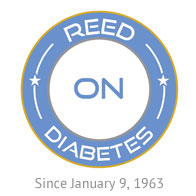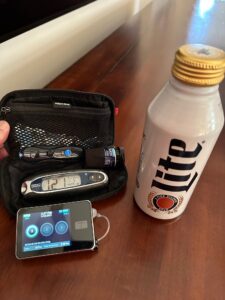For me, most evenings include a pint or two of Miller Lite (occasionally red wine) just before or during dinner. It’s been a daily ritual for years and a way of transitioning from the ‘productive’ part of my day into a relaxing evening. I hardly ever have more than two drinks as my brain and body are done with alcohol at that point.
Why Dry January?
I decided to go alcohol-free on New Year’s Day after drinking several beers and a glass of wine the night before. It was a fun outing with family, but it made me feel bloated and less sharp. Again.
I’ve also wondered about the caloric impact of alcohol. Each drink is 120 calories and usually followed by the munchies … which play havoc with my blood sugars. My weight has been stable for years, but still, I was curious how no alcohol for a month would influence my body weight. And yes … I was interested in how it would impact my diabetes management and blood glucose levels.
Here’s how it went.
31 Days Alcohol-Free
With little fanfare, I made it through the month with no alcohol. I felt good and confident about my decision from day one. Not making the walk to the fridge every evening felt somewhat liberating. I needed a substitute and found it in unsweetened iced tea and water.
I handled happy hours and dinners with friends and family ok. I shared my dry January and most responded with a non-judgmental, “Oh, ok.” Some asked why, and I said I was starting the year with a monthly cleanse. Others defended their drinking use and patterns. I was surprised there weren’t others in my close circle of 15-20 participating as I’d read that 1 in 5 adults was trying dry January.
For a few days, I thought about cracking a beer open before dinner, but the feeling wasn’t overwhelming. I was surprised that my urge for such a long-standing habit wasn’t stronger.
But what about specific areas?
Blood Glucose Levels: more consistent & predictable
Blood sugars were more consistent after dinner and continued overnight into the morning. There are a couple of reasons. First, alcohol can numb the liver (I wonder if two drinks are enough) and delay the digestion of carbohydrates. Second, cravings for food after consuming alcohol occur after alcohol (yep, the munchies). My eats then are mostly high in carbohydrates and fat (crackers, peanut butter and ice cream). They, in turn, require an extended bolus SWAG (Sophisticated Wild Ass Guess). (I’ve gotten pretty good at nailing these). Without alcohol, I eliminated a demand for carbohydrates and the insulin required to tame them. The result? More consistent blood glucose levels.
Brain Function: sharper
My mind felt sharper throughout 2-3 hour dinner conversations. I felt more controlled and consistent in my listening, thought process, and verbal communication. I enjoyed them more, and my memory recall improved. And research backs it up … check out this link to a Newsweek article that shares how alcohol impairs the ability to encode short-term memories.
Weight: less (just not in January)
Losing weight is easy math … fewer calories (*).
Sans two Miller Lites a day (120 calories/pint) meant 7400 fewer calories in January (120 calories*2*31 days). 3500 calories of energy usually result in a loss of one pound, so dry January could have resulted in a loss of 2.12 pounds (7400/3500). But my November and December also had less alcohol due to the hip surgeries.
A better way to look at alcohol’s influence on my weight is to compare October (full month of alcohol) to November, December, and January. My weight in October was 190 pounds … in January, I ended the month at 183 pounds. A 7-pound weight loss over three months is 2.3 pounds per month.
(*) it’s easy math, but the variables are complex. Calories in are what we eat; calories out (burned) come from our metabolic rate, digesting food, and physical activity.
Sleep: no change
I have no problem going to sleep. But for two decades, I’ve awakened after 3-5 hours of good shuteye, stayed up for 30-90 minutes, and returned for another 2-3 hours. I thought alcohol could be a culprit as people wake up once alcohol is fully processed hours later. It turns out alcohol is not the culprit for my sleep interruption … my down, up, and down sleep patterns continued.
Exercise: no change
Others doing dry January mention increases in exercise as they use it as a substitute for drinking. My exercise levels did not change … I continued to work out 3-5x/week during January. The intensity levels of my workouts were less as I’m recovering from two hip surgeries in late October and November.
Moving Forward
I missed alcohol and the perceived relief and recognition it provides for a productive day. And though I felt included in conversations over dinner while others were drinking, alcohol is a conduit to connecting with others. I’ve often accomplished more after-hours over drinks than in long discussions during the day. And alcohol serves as a celebratory salute to people’s accomplishments.
While I anticipated weight loss, there are other ways to accomplish it without alcohol. The surprising benefits were a sharper, more responsive brain and improved blood glucose levels. Those are reasons for drinking alcohol in moderation for people with diabetes.
Based on the above, I’m adjusting my approach to alcohol … here is my plan moving forward:
- Drink in moderation … fewer than 3-4 days and five or fewer drinks a week,
- Integrate iced tea or water with a light beer over dinner,
- Embrace the occasional celebration that includes alcohol (it clears cobwebs!),
- Observe my craving for beer after restarting outdoor cycling … there is a narrative that exercising over longer times (2-4 hours) increases the desire for alcohol.
Doing Dry January was a mild sense of accomplishment. It was a month-long commitment … that’s a drop in the bucket compared to the dedication involved in managing diabetes. I am better for doing it and believe drinking alcohol in moderation, especially with diabetes, is best.


